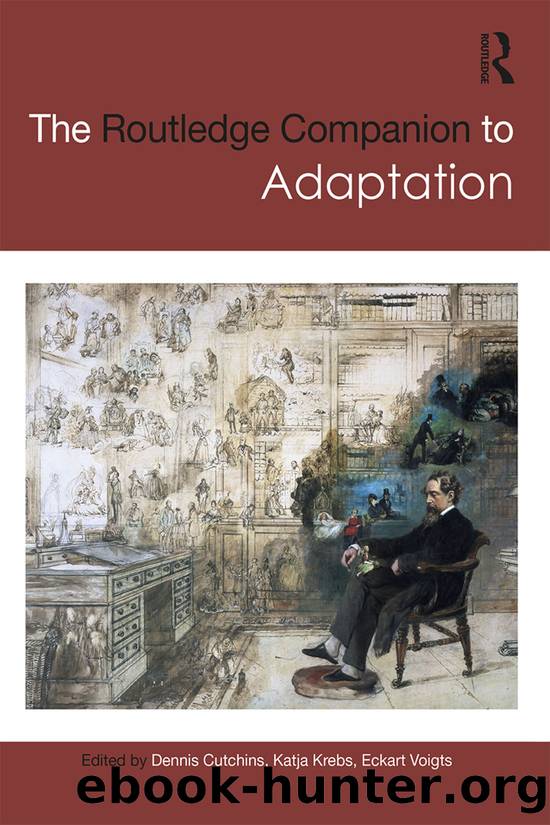The Routledge Companion to Adaptation by Dennis Cutchins Katja Krebs and Eckart Voigts

Author:Dennis Cutchins, Katja Krebs and Eckart Voigts
Language: eng
Format: epub
Publisher: Routledge
18
Adapting identities
Performing the self
Katja Krebs
As has been observed on numerous occasions, adaptation studies has broadened its scope of enquiry for better or worse from the relatively narrow field of literature to film adaptations. This Companion is a case in point where the chapters in sections such as history, identity, reception and technology go far beyond the limited novel-to-film model. Adaptation studies now encompasses studies that engage with rewriting, appropriation, intertextuality and intermediality as examples of processes and products of adaptation. For some scholars, such proliferation is a step (or three) too far and they offer a convincing argument why adaptation studies needs to undergo a process of disambiguation and pay more attention to the development of a more particular definition of adaptation (see, for example, Cardwell in this collection) in order to establish more clearly a much-needed analytical aesthetics of adaptation. Furthermore, adaptation studies has yet to excise its, arguably, over-reliance on the case study at the expense of more detailed consideration of the conceptual framework within which we read adaptations. And while the case study is a well-established and rigorous methodology, it will only move the field of adaptation studies on if it becomes a means to a conceptual end rather than an end in itself.
Being fully aware of the dangers inherent in the broadening of a concept of adaptation to contain elements of intertextuality, a position which could lead to an adaptation studies without focus, I would also like to embrace the scope that an adaptation studies which refuses to settle on a narrow definition of its field brings with it. As a result, what follows is a consideration of a series of case studies, arguably more intertextual than adaptational by nature, in order to develop further the concept of adaptation rather than concentrate on the specifics of the case studies themselves only. Such an analysis has the potential to offer not only a detailed consideration of processes of adaptation in themselves but, importantly, processes and positions of identity construction through adaptation, performance and reception. As such, this chapter’s aim is to contribute to the development of adaptation studies through a discussion and analysis of notions and displays of identity through adaptation.
While looking for suitable examples of adaptation of identity and adaptation as identity in the Theatre Collection at the University of Bristol as long ago as 2014, I came across boxes of so-called miscellaneous content, ordered in appearance yet un-catalogued beyond assigning letters of the alphabet to its material: a–c, d–f and so forth. And within those boxes were hidden stories of performers whose acts were based on various forms of identity construction through adaptation. A number of these performed identities seemed based upon constructions of cultural identities through the adaptation and performance of national identity. And the very fact that their content became known by happenstance as miscellaneous items rather than through cataloguing is noteworthy in terms of the position the archive plays vis-à-vis non-canonised popular performance and adaptation practices. While the role the archive plays
Download
This site does not store any files on its server. We only index and link to content provided by other sites. Please contact the content providers to delete copyright contents if any and email us, we'll remove relevant links or contents immediately.
Call Me by Your Name by André Aciman(20351)
Ready Player One by Cline Ernest(14497)
How to Be a Bawse: A Guide to Conquering Life by Lilly Singh(7364)
Wiseguy by Nicholas Pileggi(5650)
The Kite Runner by Khaled Hosseini(5061)
On Writing A Memoir of the Craft by Stephen King(4847)
Audition by Ryu Murakami(4822)
The Crown by Robert Lacey(4710)
Call me by your name by Andre Aciman(4599)
Gerald's Game by Stephen King(4556)
Harry Potter and the Cursed Child: The Journey by Harry Potter Theatrical Productions(4429)
Dialogue by Robert McKee(4306)
The Perils of Being Moderately Famous by Soha Ali Khan(4156)
Dynamic Alignment Through Imagery by Eric Franklin(4100)
Apollo 8 by Jeffrey Kluger(3621)
Seriously... I'm Kidding by Ellen DeGeneres(3564)
The Inner Game of Tennis by W. Timothy Gallwey(3557)
How to be Champion: My Autobiography by Sarah Millican(3544)
Darker by E L James(3463)
